When most people think of World War Two era German Luftwaffe jets, the Messerschmitt Me 262 Schwalbe jet fighter would probably be the first one to spring to mind but this was not the only Junkers Jumo 004 turbojet powered aircraft to reach operational status over the battlefields of Europe. The Arado Ar 234 Blitz (Lighting) reconnaissance jet bomber prototype took flight for the first time in June 1943 but it was not until August 1944, when deployed over the western front, that it became the worlds first operational jet bomber.
The Ar 234 was only produced in limited numbers and too late to make any major impact on the outcome of the war. A small number did reach frontline squadrons and they were primarily used as a fast reconnaissance aircraft to keep tabs on advancing Allied forces, whilst outpacing Allied fighters but from December 1944 strike bombing missions were also conducted. In April 1945, during a reconnaissance mission, the type was the last Luftwaffe aircraft to conduct a sortie over England during the war.
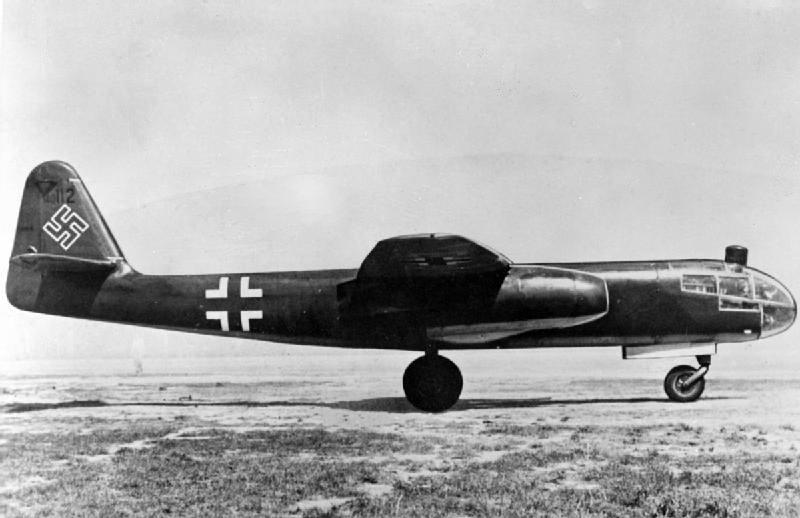
Wunderwaffe
Adolf Hitler had a desperate vision of Wunderwaffe (“Miracle Weapons”), more often referred to in English as Wonder Weapons, to strike back at the ever advancing Allies. The deployment of such weapons were mostly on the Western Front, such as the V-1 flying bomb, V-2 rockets to hit England and the Me 262 jet fighter. His desire for a fast jet bomber delayed and pretty much crippled the Me 262 program (see my previous post) but the Arado Ar 234 Blitz Schnellbomber (“fast bomber” – essentially a strike bomber) finally meant that production of the Me 262 could concentrate on fighter jets rather than Sturmvogel (Stormbird) bomber variants (all too late to stem the vast number of Allied bombers over Europe).
Development
Following an order issued by the German Aviation Ministry, the Arado engineering team under Walter Blume and Hans Rebeski began working on the Ar 234 design in late 1940 (originally known as the E.370) and two prototype airframes were completed by the end of 1941 but Junkers Jumo 004 turbojet engines would not become available until early 1943 (engines for the Me 262 also had priority over the Ar 234). The first prototype Ar 234V1 flew on June 15th, 1943 and four prototypes were flying by September 1943.
The second prototype, Ar 234V2 crashed on October 2nd, 1943 due to a fire starting in its port wing and dual engine failure! Unfortunately the pilot was killed in the resulting crash.
The sixth and eighth prototypes were actually fitted with four BMW 003 A-1 turbojet engines, with Ar 234V6 having a configuration of 4 individual underwing engine nacelles and Ar 234V8 having two engines in a paired twin-engine nacelle under each wing. These became the first four engine jet aircraft to fly and although less powerful than the Junker Jumo 004, gained a 20% increase in speed (870 km/h / 540 mph) and increased climb rate over the two engine Ar 234B variants, as they were lighter and increased the aircrafts overall thrust-to-weight ratio (it was also an engine deemed unsuitable for the Me 262, so although limited in number it was more readily available).
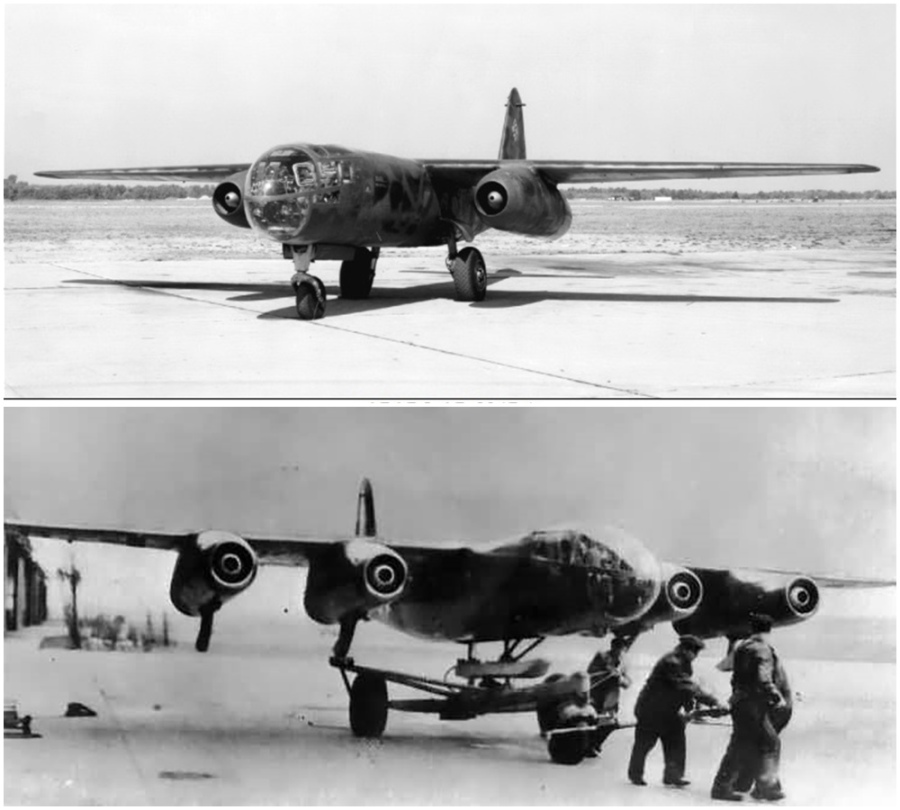
To save internal space for fuel tanks, the early prototypes were fitted with retractable landing skids and were launched on a jettisonable wheeled trolley (similar to the Messerschmitt Me 163 Komet rocket powered interceptor). The landing skid was an unsafe and flawed concept for a large jet aircraft – they had to land on grass strips and it also made the aircraft very vulnerable to air attack once back on the ground until it could be lifted back up on a trolley to be moved! Later Ar 234 aircraft had a slightly enlarged fuselage to accommodate a retractable tricycle landing gear – this extra weight resulted in a loss of speed from prototype to production aircraft of around 30 km/h (19 mph).
Interestingly the prototypes had rear facing twin 20mm MG 151 cannons mounted in the tail to fire at chasing aircraft – they were aimed using a rear facing periscope sight. To save weight the guns were generally not installed on operational aircraft as they were considered ineffective and the pilots would simply jettison their bomb load or fuel tanks and accelerate away from the threat instead. The periscope to view behind the aircraft was retained though.
Arado engineers had designed a fast, single seat reconnaissance bomber with a very streamlined and slender fuselage. Entry into the streamlined glass enclosed cockpit of the Ar 234 appears to have been very clunky, with the pilot having to enter via a small hatch atop the cockpit. I can only imagine how difficult, if not impossible it would have been for the pilot to escape the cockpit quickly whilst in the air or even on the ground in a scenario like and engine fire!
The fuselage design meant an internal bomb bay could not be accommodated and bombs were fitted to three external hard points with a 1,500kg / 3,300 lb total payload. One hard point was under the fuselage and one under each engine nacelle – typically three 500 kg bombs would be carried as a maximum bomb load.
Given the B-2 bomber variant only had room for one crew member, the pilot was also the bombardier and a Lotfe 7K bombsight was fitted in the fuselage floor ahead of the control column, which interestingly would be moved out-of-the-way to use the sight and the Ar 234 would be under the flight control of a Patin PDS autopilot (evidently on a fast level approach) and whilst the target was in the bombsight crosshairs, the autopilot would adjust accordingly and the bombsight released the bombs automatically upon reaching a specified target point. For bombing runs conducted on a slight diving angle, the pilot used the periscope sight above the cockpit.
The B-1 reconnaissance variant carried a pair of external fuel drop tanks instead of bombs, to maximise their operational range. They were fitted with two downward facing Rb 50/30 reconnaissance cameras were fitted in the rear fuselage. They were capable of rapidly taking photos over a wide area.
The pair of Junkers Jumo 004B-1 axial-flow turbojet engines provided a top speed of 742 km/h (461 mph) making Blitz (Lightning) a very appropriate name! The production Junkers Jumo 004 engines proved to be an issue due to engine failure and short life span though resulting in repairs and replacement after only a short period of flying hours (as with the Me 262) – reportedly this could be after less than 10 hours of operation!
Ar 234 aircraft could be fitted with a pair of underwing liquid-fueled Walter HWK 109-500 Starthilfe (“Start-Help”) Rocket Assisted Take-Off (RATO) units to aid in take-off when heavily laden with bombs and could produce 1,100 lb of thrust for thirty seconds. The RATO units were jettisoned after the T-Stoff monopropellant fuel was expended (stabilised high-test peroxide) – the forward end of the rocket pods were fitted with external parachutes to descend to earth for reuse after jettison.


Production
Only 210 Arado Ar 234B Blitz production aircraft were built as the Ar 234B-1 reconnaissance variant and the Ar 234B-2 bomber (far less than the thousands that would have been required!). Arado actually only built B-2 variants but converted them to the reconnaissance standard as required.
14 four engine Ar 234C aircraft were built with an improved pressurised cockpit and powered by four BMW 003 A-1 turbojet engines with the paired twin nacelle design, which had proved to be more aerodynamically sound – only half had engines though and flight testing of the others had not been completed by the end of the war. Other variants were planned but none were completed, including an Ar 234C-3N night fighter and numerous two seat reconnaissance bomber and night fighter variants.

Operational Use
The fifth prototype, Ar 234V5 piloted by Oberleutnant Erich Sommer of the Versuchsverband OKL (headquarters unit), conducted the first ever jet reconnaissance mission on August 2nd, 1944 over Normandy, gathering valuable intelligence information (and the insurmountable forces that had landed on the beaches!). He was unchallenged from Allied fighters due to the high altitude and speed of the aircraft (the service ceiling was 10,000 metres / 33,000 feet).
Both prototype Ar 234V5 flown by Sommer and Ar 234V7 flown by Hauptman Horst Götz were used on 13 more reconnaissance flights out of bases in France and Holland, operating as Kommando Götz. They were also unchallenged.
The Ar 234 reconnaissance flights proved elusive as it was not until late November 1944 that USAAF pilots first reported a sighting of the aircraft above them over the Netherlands. By the time an Allied fighter could climb to the same height, the Ar 234 pilot would have engaged his speed advantage to safely depart the area.
The early reconnaissance flights were a success and Kommando Sperling (“Sparrow”) was formed in November 1944 at Rheine, as an Ar 234B-1 reconnaissance unit. Sommer continued to fly reconnaissance missions. This unit was disbanded in January 1945 and absorbed into 1./FAGr 100, which continued to operate as a reconnaissance unit until May 1945 (they first received three Ar 234B-1’s in December 1944).
Oberleutnant Erich Sommer transferred to Biblis, Germany In November 1944 and flew reconnaissance missions over western Europe in the one aircraft (Werk Nummer 140340) of Kommando Hecht. By January 1945 he was encountering Allied fighters on missions but continued to fly unscathed. One of his missions that month entailed circling Antwerp for thirty minutes to monitor V-2 rocket strikes upon Allied positions within the city and port.
On January 30th, 1945 Sommer was ordered to form a reconnaissance unit in Osoppo, Italy with his current ground personnel (Kommando Sommer). His Ar 234B-1 was handed to 1./FAGr 100 and Kommando Hecht was disbanded on February 1st.
The runway at Osoppo, Italy was not long enough for jet operations and by March 1945 was still not ready, so the unit were based at Udine-Campoformido instead. Kommando Sommer did not make its first Ar 234B-1 operational sortie until March 19th, 1945 (piloted by Sommer himself). The units airbase was subject to heavy and ongoing Allied fighter attacks throughout March and April 1945 but despite damage and destruction to aircraft on the ground, reconnaissance missions continued – Allied aircraft were reporting sightings of “Me 262’s” in Italy.
It was not until April that an Ar 234B-1 was shot down by an Allied fighter over Italy. Towards the end of April the low supply of fuel began to reduce reconnaissance missions as German forces began to rapidly withdraw from the Allied advance in Italy. The last surviving Ar 234’s were withdrawn from Italy by the end of April 1945. Erich Sommer survived the war and passed away in Adelaide, Australia at the ripe old age of 93! Luftwaffe reconnaissance units 1./FAGr 33 and 1./FAGr 123 also operated the Ar 234B-1 during the war.
The Ar 234 began to be used for limited fast strike bombing missions from December 1944 by Kampfgeschwader 76 (KG 76 or Bomber Wing 76) – the only operational Ar 234 bomber unit (they also conducted reconnaissance missions). Some well-known sorties were completed during the Ardennes Battle of the Bulge in January 1945, along with mostly unsuccessful attacks on the vital American held Ludendorff Railway Bridge at Remagen in March 1945 (III/KG 76 aircraft attacked with 1,000kg bombs) and final missions against advancing Soviet forces near Berlin in April 1945. A number were lost in combat though from air interception and ground fire (anti-aircraft fire took its toll during the attacks on the bridge at Remagen).

Two Ar 234B-2 aircraft (Werk Nummer 140145 and 140146) were converted to Neptun radar equipped experimental night fighters armed with twin forward-firing 20mm MG 151 cannons within a conformal gun pod fitted on the ventral fuselage hard point – these were redesignated Ar 234B-2/N Nachtigall (“Nightingale”). A second crew member was added to the aircraft to operate the radar but the poor man had to sit in a cramped compartment in the rear fuselage! The aircraft flew with the experimental Kommando Bonow unit under the command of Hauptman Kurt Bonow in March 1945 but the type was deemed unsuitable as a night fighter and achieved no aerial victories.
Apart from engine issues, the Allied fighter pilots soon developed tactics to target jet aircraft on the ground or during landing when they were low on fuel and flying slowly and like the Me 262, the Arado Ar 234 was no exception. Fuel shortages and the effects of Allied bombing on airfields and production of engines, spare parts etc. also took its toll on the operational capability of the Ar 234.
By April 1945 only 38 Ar 234 aircraft were in operational service with the Luftwaffe. This total included 24 B-1 reconnaissance aircraft, 12 B-2 bombers and the 2 B-2/N night fighters. In the final stages of the war, the surviving aircraft of Kampfgeschwader 76 (KG 76) dispersed to airfields still under German control in northern Germany and Norway. Others that could not be flown out were destroyed to avoid them falling into Allied hands.
Captured by the Brits
Ultimately by the end of the war in Europe in May 1945, British forces had captured approximately twelve to fifteen Arado Ar 234 aircraft in northern Germany and Norway (much of this information has been translated from AirPages.ru). The first was an Ar 234B-2 (Geschwaderkennung military code “F1+MT”) from 9./KG 76 which had to make an emergency landing at Zelgersdorf on February 22nd, 1945 – it was shipped to England on March 21st, 1945 for flight and engine testing by the Royal Aircraft Establishment (RAE) at Farnborough.
Several Ar 234 aircraft were captured by the British at Grove, Denmark in 1945 and a number were transferred to the RAE at Farnborough (Werk Nummer 140466 – the undercarriage was damaged in a forced landing and it was written off, 140476 and 140608 – fates unknown). 140489 was reportedly given to the USAAF but I do not believe it was shipped to the United States (fate unknown). The others were presumably scrapped (140467 and 140486). Another was taken at Schleswig-Holstein in Germany and also transferred to the RAE on June 12th, 1945 (140113 from KG 76 – written off on October 1st, 1948).
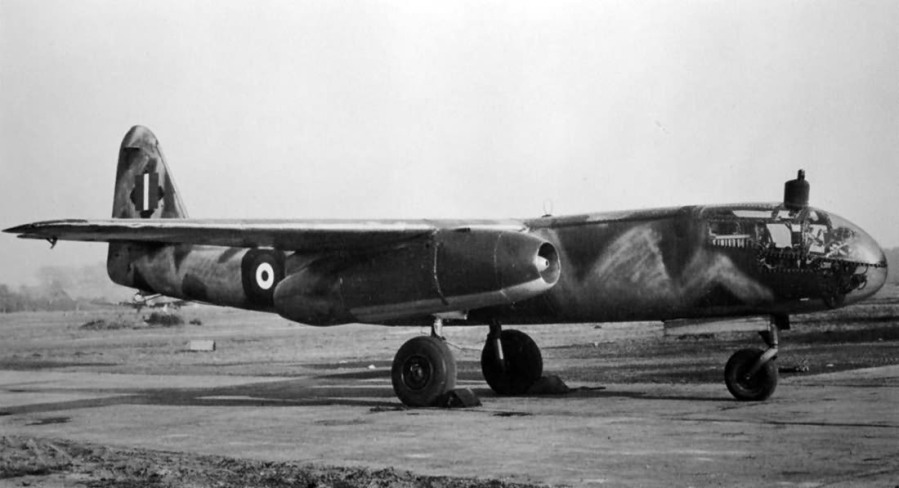
Ten Ar 234 aircraft from KG 76 were surrendered to the British at Sola Airfield near Stavanger, Norway in May 1945. A number of these aircraft were also transferred to the RAE at Farnborough between June and October 1945 (Werk Nummer 140141 – written off in October 1948, 140356 – fate unknown, 140493 – conducted 12 test flights from June 1945 and possibly scrapped in November 1945, 140581 – possibly scrapped in November 1945, 140596 from Staffel II./KG 76 was forced to make an emergency landing in Holland en route to England on October 3rd, 1945 and was handed over to the Dutch – fate unknown). 140491 was dismantled in Norway in 1945 – fate unknown.

Towards the end of the war the US Army reportedly found other Ar 234 aircraft that were presumably in a non flyable state – Werk Nummer 140107, 140175 (Staffel III./KG 76 found April 1945), 250006 (found at Monheim-Reim Airfield in May 1945). There post war status is unknown, so presumably they were scrapped.
Four of the aircraft captured by the British in Norway were handed over to the United States Army Air Force Air Technical Intelligence teams commanded by Colonel Harold E. Watson, aka “Watson’s Whizzers“, under “Operation LUSTY” (LUftwaffe Secret Technology) for flight testing by the USAAF and US Navy. The aircraft comprised Werk Nummer 140148, 143011 and 140312 from Staffel III./KG 76, and 140343 from Staffel II./KG 76.
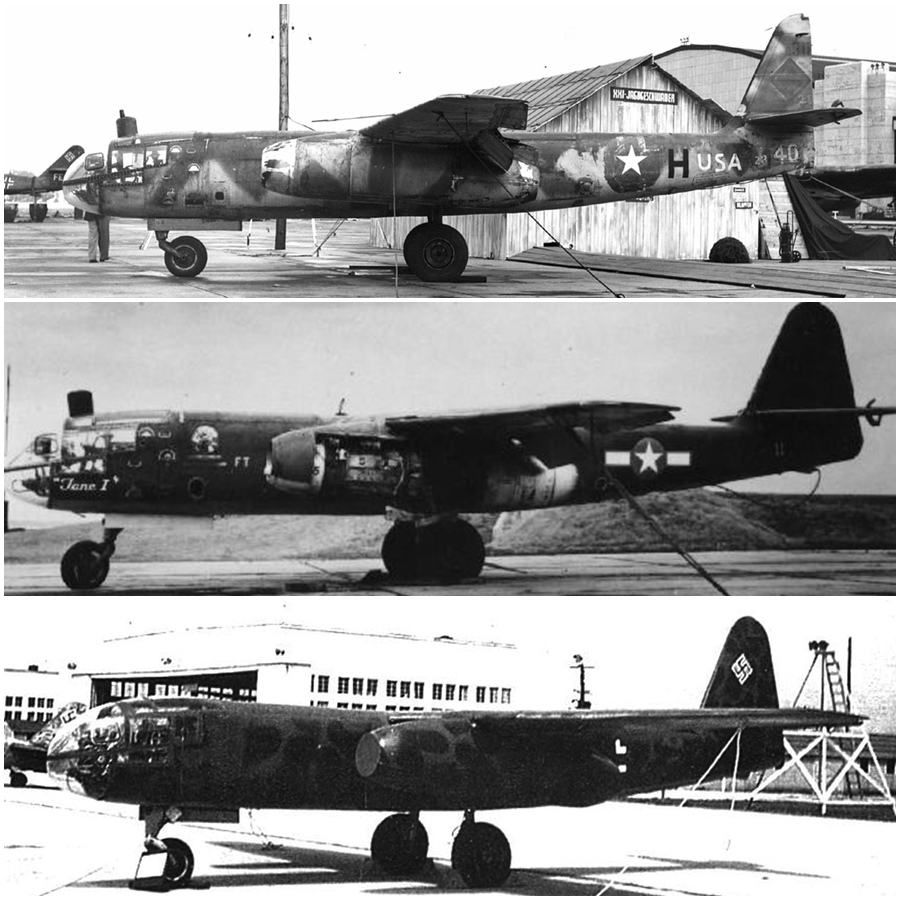
On June 24th, 1945 the aircraft were flown from Sola Airfield in Norway to Cherbourg, France to become one of 34 advanced German aircraft shipped back to the United States aboard the British Navy aircraft carrier HMS Reaper on July 20th, 1945. As was the custom of “Watson’s Whizzers“, captured aircraft received nicknames before going back to the United States and one Ar 234 had “Jane I” and another “Snafu I” painted on its forward fuselage, along with USAAF roundel and markings also applied.
HMS Reaper arrived in Newark, New Jersey just eight days later and two of the Blitz bombers were soon reassembled and flown to Freeman Field in Indiana for flight testing. Ar 234B-2 Werk Nummer 140312 was assigned the Foreign Equipment number of FE-1010 and 143011 was assigned FE-1011 – the latter seems to have been lost to the annals of history and was scrapped at Freeman Field in 1946 (I gather parts were used to keep 140312 flying).
One of the other two Ar 234 bombers shipped to Newark was also reassembled for flight testing, this time by the United States Navy at Naval Air Station Patuxent River, Maryland. Unfortunately it was determined to be unflyable. Werk Nummer 140148 and 140343 were both written off Circa 1950.
Captured by the Soviets
The Soviets also captured Ar 234B-2 (Werk Nummer 140355) in northern Germany and following repairs to the landing gear, wings and fuselage (damaged in a forced landing), conducted a short series of test flights from June 1945 and again in January to February 1946 at Rechlin north of Berlin but the aircraft experienced repeated engine issues, was eventually grounded and given it was not transported to the Soviet Union, was presumably scrapped.
There are reports that the Soviets did take an Ar 234B and Ar 234C back home and conducted test flights with at least one of these in 1946. Given they captured the Arado Flugzeugwerke factory at Brandenburg in April 1945 this is quite possible. Again if true, it would appear these aircraft were also scrapped…
The Survivor
Only one Arado Ar 234 example survives today. It is displayed in the treasure trove that is the Steven F. Udvar-Hazy Centre in Chantilly, Virginia – a massive annex of the Smithsonian National Air and Space Museum – the Arado Ar 234B-2 Blitz jet bomber variant (Werk Nummer 140312) was one of the four handed over to the United States Army Air Force Air Technical Intelligence teams commanded by Colonel Harold E. Watson aka “Watson’s Whizzers” under “Operation LUSTY” (LUftwaffe Secret Technology) in May 1945.

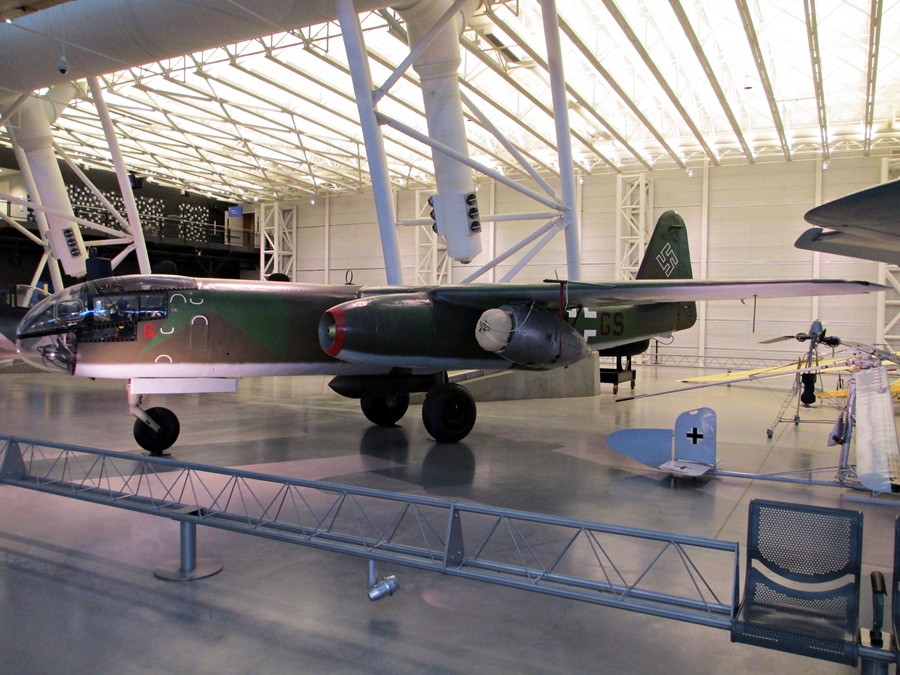

This aircraft was operated by Luftwaffe 8. Staffel III./Kampfgeschwader 76 (8th Squadron, Bomber Wing 76) from December 1944 until May 1945 before being captured by the British at Sola Airfield near Stavanger, Norway (one of nine surrendered there). The Ar 234B-2 features the Geschwaderkennung military code of “F1+GS” on the fuselage sides and a wing code of “F1”.
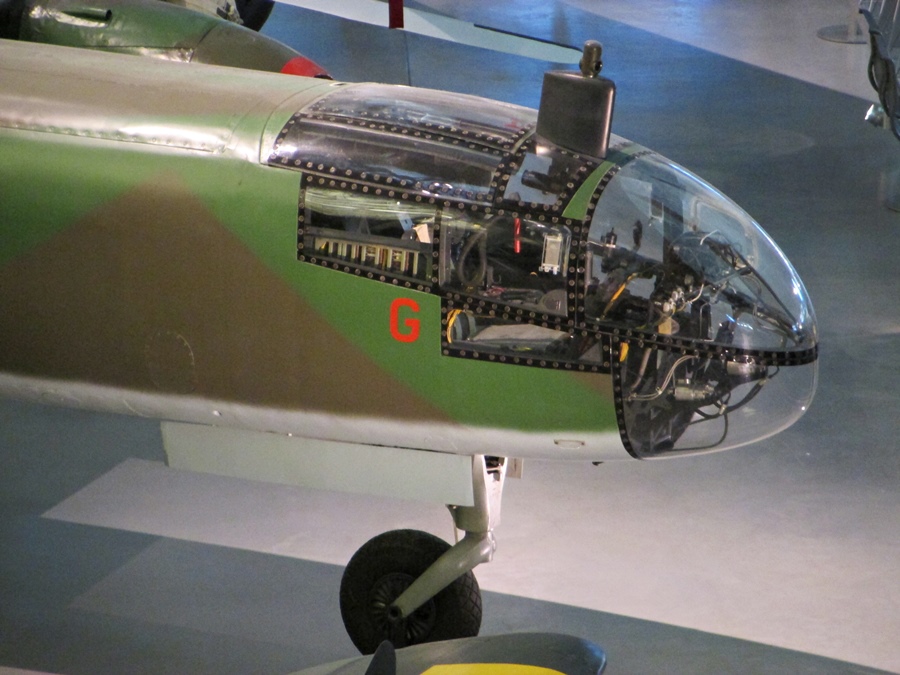

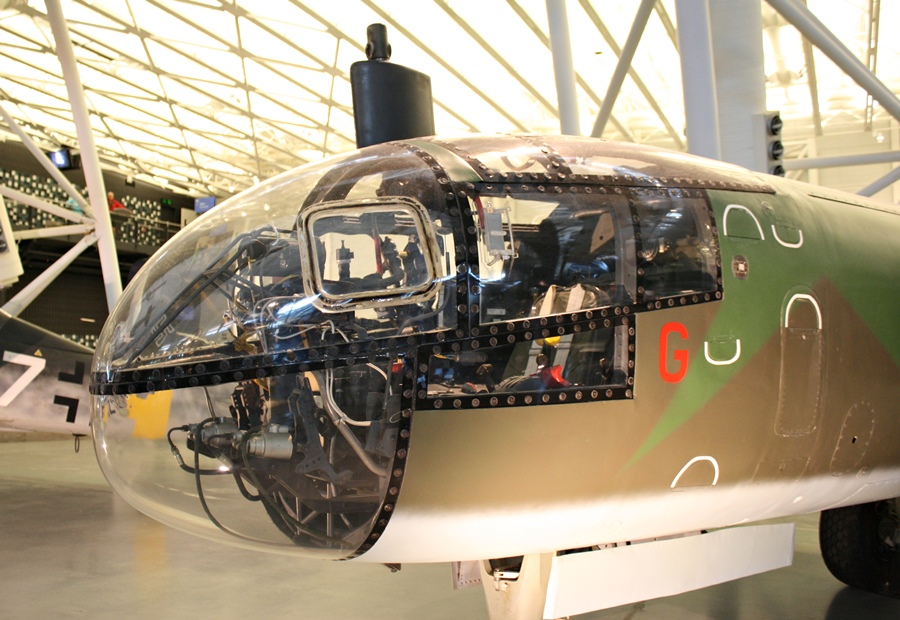
Arado Ar 234B-2 140312 was fitted with new Junker Jumo 004B-1 jet engines and new radio and oxygen equipment at Freeman Field and in July 1946 was transferred to Wright Field in Dayton, Ohio for flight testing and evaluation by the Accelerated Service Test Maintenance Squadron (ASTMS) of the USAAF Flight Test Division. Assigned a test and evaluation number of T2-1010, the flight tests were conducted from July to October 6th, 1946.
In 1947 Arado Ar 234B-2 (Werk Nummer 140312) was sent to Orchard Place Airport in Park Ridge, Illinois for storage. It was
transferred to the Smithsonian collection on May 1st, 1949 and after many years in storage was restored from 1984 to 1989. For some reason the original paint had been stripped before the aircraft entered the Smithsonian collection, so a complete repaint and reapplication of KG 76 markings was required.


The aircraft is displayed with a pair of liquid-fueled Walter HWK 109-500 Starthilfe (“Start-Help”) Rocket Assisted Take-Off (RATO) units mounted under its wings. You can clearly see the external parachutes fitted to the forward end of the rocket pods to descend to earth for reuse after jettison.
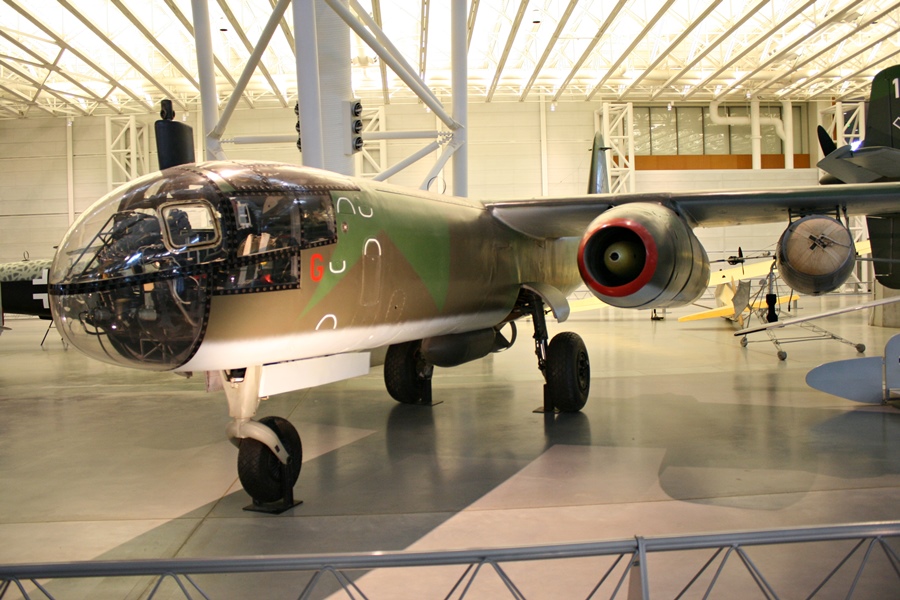
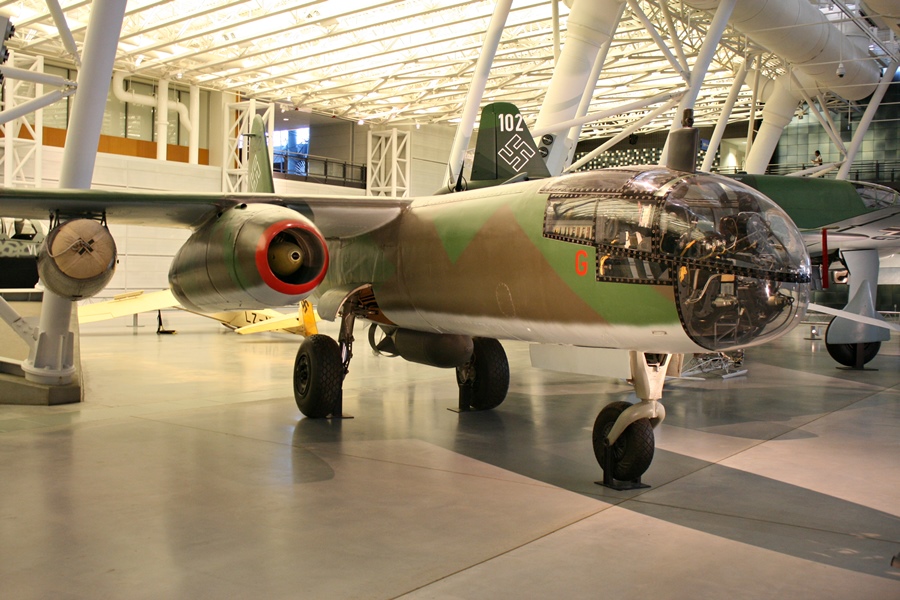
The Arado Ar 234 Blitz was a unique aircraft for its time and no doubt influenced the designs of similar looking medium jet bombers with engines underwing that were produced by the United States and Soviet Union during the early Cold War years. The early operational jet bombers such as the Ilyushin IL-28 Beagle (twin-engine) and North American B-45 Tornado (4 engines paired in a similar fashion to the Ar 234C) spring to mind and were first flown in the 1947 to 1948 period.
This blog was originally posted on Aces Flying High – The Survivors.
References:
AirHistory.net – Soviet Transports Team – Western Built Aircraft in Soviet & Eastern Bloc Service
AirPages.ru – Arado Ar 234 (English)
AirPages.ru – Arado Ar 234 (Russian)
DefenceMediaNetwork – Arado Ar 234 Blitz Came Too Late to Be a “Wonder Weapon” in World War II
Ghost Bombers – an excellent resource!
Smithsonian Air & Space Museum – Arado Ar 234
Splash One – The Story of Jet Combat by Ivan Rendall (1999 edition)

Thanks for this post of this absolutely beautiful plane. I must admit, with such a tiny bombload, it was pretty much a very, very fast Blenheim, but those German designers really knew how to produce graceful aircraft.
It was probably best as a reconnaissance aircraft, at 33,000 feet, with only the Gloster Meteor to pursue it.
LikeLiked by 1 person
Thanks. It was pretty much untouchable at altitude
LikeLike
Very interesting. It’s a shame there is only one survivor left of this remarkable aircraft.
LikeLike
Fascinating article on a little known aircraft – one shudders to think what might have been if these had been produced in numbers earlier, same goes for the Me 262. I live in Canberra and never fail to go and see the Australian War Memorias 262 whenever I visit the museum. Thanks again Deano for one of your usually informative articles.
Col
LikeLiked by 1 person
Thank Colin. A marvel for the time!
LikeLike
I saw the Arado bomber yesterday at the Smithsonian and was absolutely staggered by its small size. It was across the aisle from a P-47 (massive) and next to a FW-190 (also fairly small). The Arado was also positioned close the B-29 Enola Gay so the size comparison was easy – and the streamlined glass noses looked surprisingly alike. When I ventured over to see the Mig-15 and F-86 the size of the Arado seemed to make more sense. I’d like to line up an ME-262 and the Arado side by side for a comparison. Just seeing these – an other great planes, jets, etc at the museum – was just incredible. Jaw-dropping. I spoke with a guide who was a B-52 navigator. Simply great stories!
LikeLiked by 1 person
One of my favourite museums. Incredible collection!
LikeLike